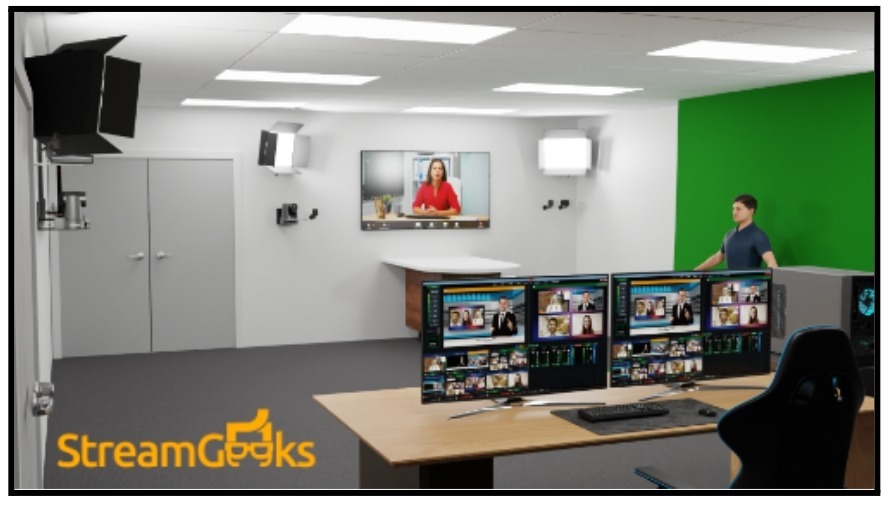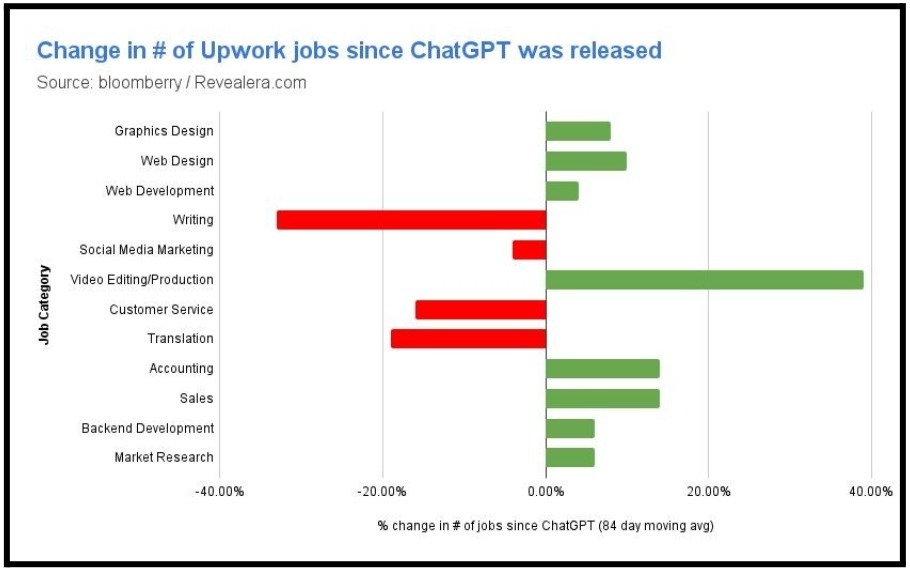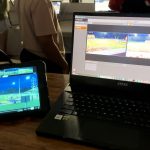Advanced Topics
Get in Touch
-
To More Inquiry
(833) 888-9706
-
To More Inquiry
[email protected]
-
534 Trestle Pl, Downingtown, PA, USA
- Home
- The Future of Broadcasting
The Future of Broadcasting

By, Paul Richards
- 9 Aug, 2024
- 804 Views
- 0 Comment

There has been huge growth in video editing and production demand in 2024 as shown with change in jobs posted on Upwork since the release of ChatGPT. The graph above shows a trend many of us have noticed in the live streaming and video production industry. Since the release of ChatGPT, it has become easier to create a video advertising plan and execute with an AI assistant. With a 40% increase in video production job demand it’s almost as if ChatGPT is recommending video campaigns to millions of users who are asking questions like “How can I grow my business in 2024?”
When I posted this question on LinkedIn, many of my peers in the industry have responded with caution and worry about the new AI video production tools that are hitting the market. One of particular interest, SORA, OpenAIs new text to video generation tool, claims that it can make “stunning” videos from a simple text prompt. If SORA is anything like ChatGPT, the industry is going to be in for some significant change. Is the temporary boost in video production going to maintain its significant growth or will it decline like other job categories such as writing and social media marketing?
One area of interest to our team is live video production. I whole-heartly believe live video content will continue to increase in value as AI video becomes more prevalent. This is because the value of “authentic” real-time video communication will increase as a result of so much “lost personal touch” with AI generated video.

From my vantage point at StreamGeeks, I’ve observed AI’s role in automating processes like video editing, a domain once heavily reliant on human expertise. Photorealistic AI-generated videos arenare already emerging. The duality of AI – as a powerful assistant and a potential replacement – is something we can’t ignore. It’s fascinating, for instance, how AI can streamline tasks such as tracking PTZ camera movements, providing transcriptions and enhancing the efficiency and creative possibilities of live streaming.
As someone working in the world of live streaming and video production, I see this as a pivotal moment. The industry stands at a crossroads where AI-generated content and the authenticity of human creativity are in a delicate balance. This isn’t just about technology overtaking tasks; it’s about redefining how we position ourselves for “productivity gains” to compete in this modern landscape.
The future of video production will likely revolve around a synergy between human creativity and AI’s efficiency. But how far will we need to pivot our skills towards areas where AI can’t replicate the nuanced understanding and creative insights we bring to the table. Learning to manage and work alongside AI, understanding its capabilities and limitations, will be crucial. We need to be the conductors of this technological orchestra, blending AI’s computational power with our irreplaceable creative spirit.
It’s great that we are seeing a temporary boom in the demand for video production but I think we are all wondering how far can AI transform the industry? A second wave of specialty-AI video production tools are on their way to being released. My message to fellow video production professionals is one of optimism and resilience. Let’s embrace this change, continue to learn, and find ways to complement our skills with AI advancements. The future isn’t about AI versus humans; it’s about how we can harmonize these forces to create content that resonates with authenticity and innovation.
Technological Advances
The future of remote production is likely to be dominated by continued advancements in artificial intelligence (AI), 5G connectivity, and next-generation streaming protocols. AI is expected to increasingly automate complex production tasks, such as video editing and camera operations, reducing the need for manual intervention and allowing for more sophisticated content creation. This automation will also aid in managing large datasets and streams, ensuring that the production can adapt in real-time to changing inputs and conditions.
5G technology will drastically enhance remote production capabilities through its ultra-fast speeds and incredibly low latency. This will facilitate more reliable and high-quality live broadcasts from remote locations and enable the use of more mobile devices and sensors in production, thereby increasing the flexibility and scope of broadcasting projects.
Globalization of Production
Remote production technologies will also continue to break down geographical barriers, enabling truly global production teams. This globalization will allow producers to select the best talent from around the world, regardless of location. Collaboration across different time zones and regions will become smoother and more efficient, enabled by cloud-based tools and platforms that support real-time communication and file sharing.
This global network of production resources will not only enhance the diversity and quality of content but will also allow for more localized and culturally relevant content to be produced on a global scale.
The evolution of remote production is set on a trajectory that promises to reshape the broadcasting landscape dramatically. With technological advances in AI, 5G, and IP-based workflows, coupled with the integration of media technologies and the globalization of production teams, the future of broadcasting looks bright. These developments will enable broadcasters to create more engaging, high-quality, and diverse content more efficiently than ever before. As the industry moves forward, embracing these changes will be key to staying competitive and relevant in the rapidly evolving media world.
Thank you for journeying through the pages of this book. You have now reached the end, but let this not be the conclusion of your learning or your exploration in the dynamic field of remote production. You are poised at the threshold of limitless possibilities, equipped with the knowledge and tools to elevate your projects and take remote production to unprecedented heights.
As you apply the insights and techniques discussed, remember that innovation thrives on collaboration and sharing. We invite you to join the StreamGeeks community—a vibrant network of enthusiasts and professionals who are passionate about streaming and content creation. Your unique experiences, challenges, and successes can inspire and enlighten others, just as you might find inspiration and guidance in the journeys of your peers.
Embrace the opportunity to transform the landscape of media production, to innovate and to lead in crafting engaging, high-quality remote productions. The future of media is not just in the technology we use but in the communities we build and the stories we share. Let your journey be bold, let your streams shine bright, and always remember—the StreamGeeks community is here to support you every step of the way.
You can stay connected with our latest updates by signing up for our StreamGeeks Newsletter we send out each month. You can sign up at StreamGeeks.us/newsletter.
Further Reading
To enhance your understanding and expertise in remote production, several additional resources are available that delve deeper into specific tools and technologies. Each of these works provides valuable insights and practical guidance that are pivotal for anyone looking to advance their knowledge in the field of remote media production:
- The Basics of Live Streaming: This book reviews the major aspects of live streaming and explores each area with simple language. It’s important to understand the fundamentals before you jump into more complicated topics. This book is a great way to bring new hires up to speed.
- The Unofficial Guide to vMix: This guide is an essential resource for users of vMix, a software that allows for live video production, including mixing, switching, and streaming. The book covers a comprehensive range of functionalities from basic setup to advanced features like instant replay and stinger transitions, making it invaluable for producing high-quality live events remotely.
- The Unofficial Guide to NDI: Network Device Interface (NDI) is a crucial technology for transmitting video over a network with minimal latency, which is fundamental in remote production environments. This guide provides a detailed look at the setup, integration, and troubleshooting of NDI systems, offering practical advice for optimizing your workflow in distributed production settings.
- The OBS SuperUser Guidebook: Open Broadcaster Software (OBS) is widely used for video recording and live streaming, with versatile capabilities suited to remote production. This guidebook serves as a deep dive into the advanced features of OBS, helping users maximize the software’s potential in creating professional-grade live streams from various locations.
- The Virtual Ticket: This book explores the concept of delivering engaging virtual experiences to audiences, which is a rapidly growing area within remote production. It offers strategies for monetizing digital events and enhancing viewer engagement, providing a blueprint for successfully navigating the digital event landscape.
- The PTZ Camera Operator Handbook: The PTZ Camera Operator Handbook is an essential guide to robotic camera operations. The popularity of streaming video content – both creating and consuming it–is transforming many people into “amateur/expert” video producers. Whether it’s streaming live video for events and community groups, work, school, sports, or home, more people are embracing video production.
Each of these texts offers a unique perspective and set of tools that can significantly benefit practitioners and enthusiasts of remote production, ensuring that readers are well-equipped to tackle the challenges and opportunities presented by remote and distributed production environments.
The Best Resources for Learning Remote Production Technology
Recent Comments
Category
- Audio (1)
- AV Management (2)
- Book (18)
- Education (1)
- NAB Show (1)
- NDI (4)
- PTZ Controls (6)
- Remote Production Software (20)
- Sports (3)
- Studio Management (2)
- Training (7)
- Uncategorized (4)
- vMix (3)
New Tags
auto-tracking AV Management AV Monitoring bandwidth Book broadcasting broadcast technology camera compatibility camera presets camera settings cloud-based platform CloudFlex color correction Education Epiphan Hive Hive PTZ Hive Setup innovative technology IP Video live production live streaming metro NAB Show NAB Show 2024 NDI NDI Video Source Peplink professional broadcasting professional video PTZ camera control PTZ Controls PTZOptics PTZOptics Hive real-time collaboration remote production remote video production Sports Sports Broadcasting USB Cameras video broadcasting video content production video equipment video production vmix



